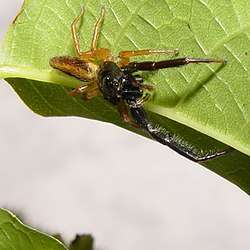Trite planiceps
| Trite planiceps | |
|---|---|
 | |
| Scientific classification | |
| Kingdom: | Animalia |
| Phylum: | Arthropoda |
| Class: | Arachnida |
| Order: | Araneae |
| Suborder: | Araneomorphae |
| Family: | Salticidae |
| Subfamily: | Euophryinae |
| Genus: | Trite |
| Species: | T. planiceps |
| Binomial name | |
| Trite planiceps (Simon, 1899) | |
| Synonyms | |
|
Salticus minax | |
Trite planiceps, commonly known as the black-headed jumping spider, is a common jumping spider (Salticidae) endemic to New Zealand and one of about 150 species of jumping spiders in New Zealand.
Description
Males and females range in body length from 6 to 13.5 mm.[1] The cephalothorax and first pair of legs are jet black. The elongated abdomen is golden brown, with a central yellow stripe, and sometimes has a greenish sheen.[2] In males, the first pair of legs is elongated, there is a row of dark hairs above the frontal eyes, and the chelicerae (mouthparts) are more robust.
Behavior
While most jumping spider rely mostly on their very acute eyesight, T. planiceps has been shown to seize on prey in the dark, probably by means of vibratory signals. Unlike typical jumping spiders, they do not make nightly web shelters. As T. planiceps lives in low altitudes, this could be an adaptation to cool overcast winters, where they need to survive within the dim recesses of rolled-up leaves of New Zealand flax (Phormium tenax) and similar plants.[3] These leaves are typically one to two meters long and 5 to 10 cm wide.
They also change from vision-based courtship in the open to vibratory courtship when mating inside a rolled-up leaf. If an immature female is within about ten days of maturing, the male will live with her for this time and then mate inside the leaf. The two are in physical contact for a while after mating, and communicate using tactile signals. Upon entering a rolled-up leaf, both sexes will tap the leaf surface with the first pair of legs and vibrate their abdomen.[4]
Juveniles and subadults build flat, tubular silk cocoons with a door at each end inside rolled up leaves. Adult females build a silk platform 50% longer and two to three times wider than their own size before laying up to seven egg batches with 8 to 40 eggs each. Each batch is enclosed in its own silk casing. Males normally do not build nests.
A wide array of behavioral patterns has been observed, among others ritualized male duels.
They are aggressive when threatened and often turn to face what is threatening them instead of running away. They bite as a last resort. The bite is non lethal. The area around the bite will immediately turn red and swell up. The initial bite itself is painful though its relatively brief. There will be two red dots where the bite is and they can draw blood. The area can be itchy long after the bite and touching it can bring a dull pain. After 72 hours all signs of the bite have usually gone.
They are usually quite a docile spider around humans. Their bite is a last resort and they have to be provoked a lot to bite.
They are often found roaming in a home and can cover great distances in a house. They are quite a safe spider to be in a home and can deal with other insect problems because of the amount they travel in a short period of time.
References
- ↑ Vink, Cor J., Dupérré, Nadine, McQuillan, Bryce N. (2011): The black headed jumping spider, Trite planiceps Simon, 1899 (Araneae: Salticidae): redescription including cytochrome c oxidase subunit 1 and paralogous 28S sequences. New Zealand Journal of Zoology 38: 317-331.
- ↑ Early, John (2009). Know your New Zealand ... native insects & spiders. New Holland. p. 28. ISBN 9781869662530.
- ↑ Forster, Lyn M. (1982): Non-visual prey-capture in Trite planiceps, a jumping spider (Araneae, Salticidae). Journal of Arachnology 10: 179-183. PDF
- ↑ Taylor, Phillip W. & Jackson, Robert R. (1999): Habitat-adapted communication in Trite planiceps, a New Zealand jumping spider (Araneae, Salticidae). New Zealand Journal of Zoology 26: 127-154. PDF Archived 2009-10-03 at the Wayback Machine.
External links
| Wikimedia Commons has media related to Trite planiceps. |
- Jumping spiders (family Salticidae), Museum of New Zealand Te Papa Tongarewa
- Salticidae.org: Diagnostic drawings + photographs